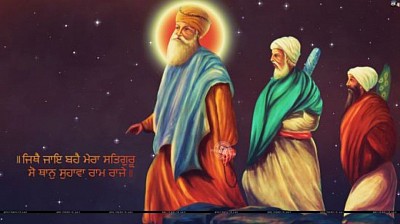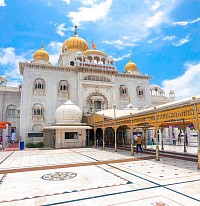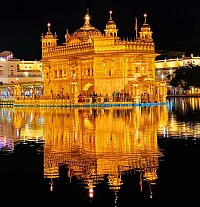ABOUT OF SIKH RELIGION
Guru Nanak Dev Ji, the founder of Sikhism, was born in 1469 in the town of Nankana Sahib, now in Pakistan. His teachings emphasize the oneness of God, equality of all humans, and the importance of selfless service. The term "Jiwani" typically refers to his life story and the spiritual journey he undertook, spreading a message of love, compassion, and devotion.
The ten Sikh Gurus are:
1. Guru Nanak dev ji
2. Guru Angad dev ji
3. Guru Amar Das ji
4. Guru Ram Das ji
5. Guru Arjan ji
6. Guru Hargobind ji
7. Guru Har Rai ji
8. Guru Har Krishan ji
9. Guru Tegh Bahadur ji
10. Guru Gobind Singh ji
The five beloved ones, known as the Panj Pyare, are:
1. Bhai Daya Singh ji
2. Bhai Dharam Singh ji
3. Bhai Himmat Singh ji
4. Bhai Mohkam Singh ji
5. Bhai Sahib Singh ji
The "Char Sahibzade" refers to the four sons of Guru Gobind Singh, the tenth Sikh Guru. Their names are:
1. Baba Ajit Singh ji
2. Baba Jujhar Singh ji
3. Baba Zorawar Singh ji
4. Baba Fateh Singh ji
The "Five Ks" or "Five Kakars" are the five articles of faith worn by baptized Sikhs, known as Amritdhari Sikhs. They are:
1. Kesh: Uncut hair
2. Kara: Steel bracelet
3. Kanga: Wooden comb
4. Kachera: Cotton undergarments
5. Kirpan: Small sword or dagger
The Panj Pyare, or Five Beloved Ones, in Sikhism are:
1. Bhai Daya Singh
2. Bhai Dharam Singh
3. Bhai Himmat Singh
4. Bhai Mohkam Singh
5. Bhai Sahib Singh
"Sikh Tirth Sathal" refers to significant pilgrimage or historical sites for Sikhs. Some important ones include:
1. **Golden Temple (Harmandir Sahib):** Located in Amritsar, Punjab, it is the holiest Gurdwara and a central religious place for Sikhs.
2. **Anandpur Sahib:** A city in Punjab closely associated with Guru Gobind Singh and the formation of the Khalsa.
3. **Hemkund Sahib:** A high-altitude Sikh pilgrimage site in the Himalayas, known for its scenic beauty and the Hemkund Lake.
4. **Patna Sahib:** The birthplace of Guru Gobind Singh, located in Bihar.
5. **Takht Sri Hazur Sahib:** A Gurdwara in Nanded, Maharashtra, marking the site where Guru Gobind Singh left his physical form.
These sites hold historical and spiritual significance for the Sikh community.
History of Gurudwara Bangla Sahib
Bangla Sahib, also known as Gurudwara Bangla Sahib, is one of the prominent Sikh gurdwaras in Delhi, India. The historical context of Bangla Sahib is associated with the eighth Sikh Guru, Guru Har Krishan Sahib Ji.
According to Sikh history, during the smallpox and cholera epidemic in Delhi in the 17th century, Guru Har Krishan visited the city to provide solace and aid to the suffering. He stayed at the bungalow (bangla in Hindi) of Raja Jai Singh, which is where the gurdwara stands today. Guru Har Krishan is said to have miraculously cured people through his blessings.
The establishment of Gurudwara Bangla Sahib commemorates Guru Har Krishan's selfless service to humanity. The gurdwara includes a holy pond, Sarovar, and the main building with a golden dome. It serves as a place of worship, reflection, and community service, continuing the Sikh principles of selfless service and compassion.
History of Gurudwara Sis Ganj Sahib
Gurudwara Sis Ganj Sahib is a historical Sikh shrine located in Chandni Chowk, Delhi, India. Its historical significance is deeply rooted in the martyrdom of Guru Tegh Bahadur, the ninth Sikh Guru.
In 1675, during the reign of Mughal Emperor Aurangzeb, Guru Tegh Bahadur was executed at this site for his defense of religious freedom and human rights. He opposed the forced conversion of Hindus to Islam and, as a result, faced severe persecution. Guru Tegh Bahadur's beheading took place at Sis Ganj Sahib.
The name "Sis Ganj" refers to the method of execution, where the head (sis in Hindi) was severed. Despite the tragic event, the martyrdom of Guru Tegh Bahadur is considered a symbol of sacrifice for the protection of religious freedom and tolerance.
Gurudwara Sis Ganj Sahib stands as a historical reminder of the Sikh struggle for justice and religious liberty. It is a revered place of worship for Sikhs and attracts visitors seeking to understand and reflect on the principles of Sikhism.
History of Gurudwara Golden Temple
The Golden Temple, officially known as Harmandir Sahib, is the holiest shrine in Sikhism and one of the most revered religious sites in the world. Here's a brief history:
1. **Construction:** The construction of Harmandir Sahib was initiated by Guru Arjan, the fifth Sikh Guru, in the early 17th century. The foundation stone was laid in 1588, and the construction was completed in 1604.
2. **Architectural Significance:** The architecture of the Golden Temple is a blend of Hindu and Islamic styles, symbolizing the Sikh tenet of inclusivity and harmony. The temple is surrounded by the sacred Amrit Sarovar (Pool of Nectar).
3. **Adi Granth Installation:** Guru Arjan also compiled the Guru Granth Sahib, the holy scripture of Sikhism, and installed it in the Golden Temple. This emphasizes the central role of the scripture in Sikh worship.
4. **Destruction and Reconstruction:** During the 18th century, the Golden Temple faced attacks and partial destruction. However, it was later reconstructed by Maharaja Ranjit Singh, the founder of the Sikh Empire, in the early 19th century. He covered the upper floors with gold leaf, giving the temple its distinctive appearance.
5. **Symbol of Sikhism:** The Golden Temple is a symbol of Sikh identity, unity, and the principles of equality, humility, and service to humanity. It attracts millions of pilgrims and visitors from around the world every year.
Despite challenges throughout history, the Golden Temple remains a spiritual and cultural beacon for Sikhs and a place of profound significance for all those who visit.
History of Gurudwara Anandpur Sahib
Anandpur Sahib, founded by Guru Tegh Bahadur, is a significant Sikh pilgrimage site in Punjab, India. It holds historical importance as the birthplace of the Khalsa, where Guru Gobind Singh introduced the Sikh initiation ceremony known as Amrit in 1699. The town has witnessed key events in Sikh history, including battles and the establishment of Sikh martial traditions. Despite facing numerous invasions, Anandpur Sahib remains a revered center of Sikh culture and spirituality.
History of Gurudwara Hemkunt Sahib
Hemkund Sahib is a Sikh pilgrimage site located in the state of Uttarakhand, India. It holds historical and religious significance for Sikhs. The history of Hemkund Sahib is closely associated with Guru Gobind Singh, the tenth Sikh Guru.
According to Sikh tradition, Guru Gobind Singh meditated at Hemkund Sahib in the early 18th century. The Guru is believed to have attained spiritual enlightenment at this serene mountain lake, surrounded by seven snow-capped peaks. The name "Hemkund" translates to "Lake of Snow."
The Hemkund Sahib gurdwara (Sikh temple) was established near the lake to commemorate Guru Gobind Singh's meditation and to honor the Sikh community's connection to the site. Pilgrims visit Hemkund Sahib to pay their respects and participate in religious activities.
The journey to Hemkund Sahib is a trek through challenging terrain, contributing to the spiritual significance of the pilgrimage. The site is usually open to visitors during the summer months when the snow has melted, making the trek accessible. Hemkund Sahib continues to be an important religious destination for Sikhs, attracting devotees from around the world.







